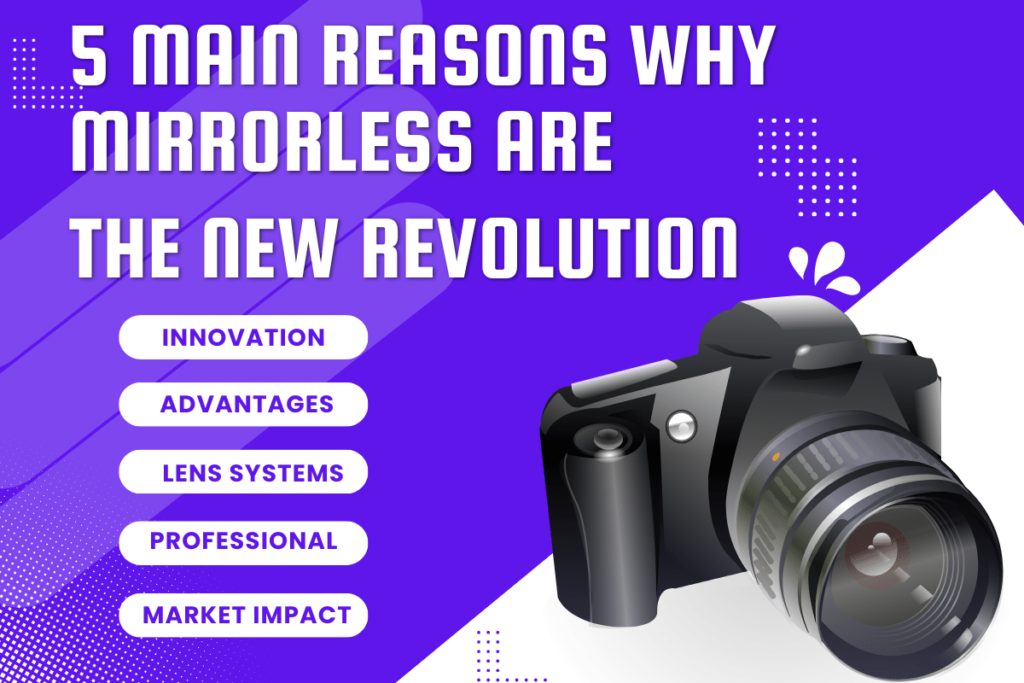
Since the first camera was invented, photography has constantly evolved. Now, mirrorless cameras are leading the charge. They’ve come a long way since their inception. They’ve shed bulk and mirror mechanisms for a sleeker, more compact design.
They’re not just a fad; they’re a revolution in the making. This article will explore why they are the new heavyweights in the photography world.
Technological Evolution and Innovation in Mirrorless Cameras
Mirrorless Technology Unveiled
Unlike traditional SLRs, mirrorless systems ditch the mirror mechanism for a digital viewfinder. What does this mean for you? A lighter, more compact design that’s changing the game.
The Sensor Renaissance
At the core of the mirrorless marvel is the sensor design. In mirrorless cameras, light falls directly onto the image sensor. This direct path enables a continuous feed to the electronic viewfinder. It gives you a real-time preview of your shot. No mirror slap means less vibration and sound, allowing for stealthy, shake-free shooting.
Autofocus: Fast and Furious
Remember when snapping a fast-moving subject was like trying to catch a fly with chopsticks? Those days are over. The latest mirrorless models boast rapid-fire autofocus systems. They lock onto subjects with precision. We’re talking about covering the frame with focus points. Algorithms predict movement like they have a crystal ball.
Artificial Intelligence: Smarter than Ever
Wouldn’t it be neat if your camera could recognize a face in a crowd or lock onto a subject’s eyes? Well, mirrorless cameras are doing just that with artificial intelligence. Eye-tracking and face detection are not just clever tricks. They are indispensable tools. They keep your subjects sharp as a tack, even when they won’t sit still.
Scene Recognition: The Clever Chameleon
Picture this: you’re out shooting, and the lighting is all over the place. Mirrorless cameras can adapt on the fly with advanced scene recognition systems. They analyze the frame and adjust settings in a snap for the perfect exposure. It’s like having an assistant inside your camera that knows exactly what you need.
Advantages and Features of Mirrorless Cameras
Portability and Ergonomics
You’ve heard it before: mirrorless cameras are changing the photography game. But what does that mean for you? For starters, portability can make or break your photography experience. Mirrorless cameras have smaller bodies and lenses compared to DSLRs. They let you avoid gear fatigue. Imagine being able to carry your camera all day without feeling like you’ve lifted weights. Now that’s a convenience you can’t overlook!
Technological Marvels
Don’t get us started on the electronic viewfinders (EVFs) and silent shooting options. These babies bring the future right to your eyes. An EVF shows a digital preview of your image. It also adjusts exposure in real time. Ever been irritated by the shutter click during a quiet moment? Silent shooting modes serve up a shush. They keep your presence discreet while you snap away.
Autofocus: Fast and Furious
Autofocus performance in mirrorless cameras isn’t just good. It’s often blazingly fast and incredibly accurate. This isn’t your grandpa’s autofocus. We’re talking about systems that lock onto subjects with the tenacity of a love-struck octopus. They make sure your shots are sharp where it counts.
Captivating Image Quality
Dive into the realm of megapixels and sensor performance. You’ll find that mirrorless cameras hold their own with pride. These cameras are designed for stellar low-light performance. They work well whether you’re shooting in broad daylight or under a blanket of stars. High megapixel counts deliver detailed images. Larger sensors capture a bounty of information, offering rich textures and dynamic range.
Video Virtuosos
Videographers appreciate that mirrorless cameras now offer 4K resolution. They even challenge traditional camcorders for the spotlight. Pair that with their in-body stabilization. You’ve got a handheld setup that allows for smooth, cinematic captures. Artistic features? Check. Advanced color profiles and flat log options? Double-check. Mirrorless cameras are, without a doubt, ready for their close-up.
Lens Systems and Camera Models
A World of Interchangeable Lenses
Your mirrorless isn’t chained to a single lens. It’s a chameleon, adapting to landscapes, portraits, or the swift action of a sports game. Interchangeable lens systems are the cornerstone of its versatility. Snap on a wide-angle for breathtaking scenery or a macro lens for minute details. You’re no longer restricted. You literally have a lens for every occasion and every artistic whim.
Adapters have further cracked open this world of possibilities. Got an old collection of lenses from your DSLR days? Hook them up with an adapter, and voilà, your mirrorless breathes new life into them. It’s a sustainable approach to photography. It keeps you and your treasured lenses shooting longer.
The Stars of the Mirrorless Universe
Let’s roll out the red carpet for the stars in this mirrorless revolution. We’re talking about brands like Sony, Canon, Nikon, Fujifilm, Olympus, and Panasonic. Each brand has made a splash with its line-up, bringing something unique to the table. Fujifilm has a retro charm wrapped around cutting-edge tech. Olympus and Panasonic are masters of the Micro Four Thirds format. They offer compact solutions with a punch. Sony’s tech innovation keeps pushing boundaries. Canon and Nikon bring their photographic pedigree to the mirrorless realm.
These brands don’t just offer cameras; they offer entire ecosystems. Lens variety is immense, from ultra-sharp primes to versatile zooms. These cameras aren’t just participating in the emerging field of 4K videography. They’re leading the charge. In-body stabilization? Check. High megapixel counts for crisp images? Absolutely.
Professional and Commercial Use of Mirrorless Cameras
When you’re capturing high-stakes moments in commercial or event photography, every second counts. That’s why mirrorless cameras have become essential tools for professionals across various photography fields.
Meeting Expectations in High-Pressure Environments
In the fast-paced world of event photography, where fleeting moments define your success, mirrorless cameras offer an unbeatable edge. They’re lighter and more compact than DSLRs. You can move quickly and stay ready for that perfect shot without feeling weighed down. These cameras have silent shooting capabilities. They allow you to capture intimate moments without being intrusive. This is critical when documenting live events or shooting commercials. Silence is golden.
Superior Quality That Challenges DSLRs
Mirrorless cameras aren’t just convenient. They also pack a punch in image quality. You’ve probably seen the stunning imagery popping up on billboards. You’ve probably seen the vivid shots in documentaries. You may have wondered about the gear behind them. Mirrorless cameras are often the secret stars. They boast high megapixel counts and incredible 4K video performance. They deliver crisp, detailed images that rival—and sometimes surpass—what DSLRs produce.
Versatility That Adapts to the Creator’s Vision
Gone are the days when you had to lug around various cameras for different needs. With a single mirrorless camera and a range of interchangeable lenses, you can adapt to nearly any scenario. From wide-angle landscapes to detailed close-ups, your mirrorless camera stands ready to capture it all. With the use of adapters, even your old, trusty DSLR lenses can come along for the ride. This extends your creative potential without breaking the bank.
Powering Through with Cutting-Edge Stabilization
Imagine shooting from a moving vehicle. Or capturing a lively festival. Situations where vibrations are your nemesis. In-body stabilization in mirrorless cameras steadies your shot. It ensures sharp images under even the most challenging conditions. This feature is a game-changer for professionals. They require consistent quality in dynamic environments.
Market Impact and Industry Considerations
When you’re eyeing the latest gear, the seismic shift of mirrorless cameras is impossible to ignore. Mirrorless revolution is more than just a buzzword. It’s reshaping photography as we know it.
Reshaping Market Trends
Mirrorless cameras aren’t just changing the game; they’re redefining it. The once-dominant DSLR cameras now share the spotlight with their mirrorless counterparts. As these nimble devices take center stage, they’re influencing market trends in a big way. Professionals and hobbyists are making the leap. They’re swayed by cutting-edge technology and portability.
But what’s the real impact? Look at the numbers. Market reports show a steady rise in mirrorless sales. DSLR figures are beginning to plateau. It’s a significant change—one that’s prompting photographers to rethink their toolkit.
Choosing Your Mirrorless Companion
So, you’re convinced that mirrorless is the new revolution. But, how do you pick your photographic sidekick? It’s not just about snapping up the fanciest model.
Budget Considerations
Your wallet will have a say in this decision—budgeting is key. Don’t worry, though; there’s a mirrorless camera for every price point. Whether you’re pinching pennies or splurging on a pro setup, there’s a match out there for you.
Lens Ecosystem
Lens choice can make or break your mirrorless experience. It’s a world of adaptability, with an ever-expanding ecosystem of lenses to explore. Brands like Sony and Canon are leading the charge. They offer everything from wide-angles for landscapes to telephotos for wildlife.
And remember those old DSLR lenses collecting dust? Grab an adapter and breathe new life into them!
Handling and Ergonomics
Opening your hands to a new camera can be like a first date—you want it to feel just right. Handling matters. Mirrorless cameras offer a range of sizes and grips, so play the field a bit. Find one that feels comfortable and compliments your shooting style.
Conclusion
You’ve seen how mirrorless cameras are carving out a new frontier in photography. They’re not just a passing trend. They’re a testament to innovation and the future of image capturing. The industry is embracing this technology. You may follow suit.
Frequently Asked Questions
What are the advantages of mirrorless cameras?
Mirrorless cameras offer a lighter and more compact design compared to DSLRs. They also provide faster autofocus, enhanced video capabilities, and access to a large selection of lenses.
How have mirrorless cameras impacted the photography industry?
The introduction of mirrorless cameras has initiated a significant shift in the industry, influencing market trends towards lighter, more versatile camera systems and contributing to a decline in DSLR sales.
Why are sales of mirrorless cameras on the rise?
The rise in mirrorless camera sales can be attributed to their compactness, innovative features, and the growing range of high-quality lenses that appeal to both professionals and hobbyists.
What should photographers consider when choosing a mirrorless camera?
Photographers should consider their budget, the lens ecosystem available for a particular camera model, and the camera’s handling and ergonomics to ensure it fits their shooting style and needs.
Are mirrorless cameras suitable for professional photography?
Yes, mirrorless cameras are suitable for professional photography as they offer high image quality, professional-grade features, and robust lens systems that meet the demands of various photography genres.

